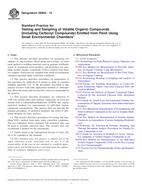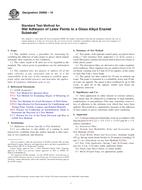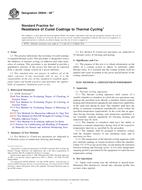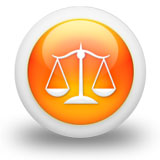We need your consent to use the individual data so that you can see information about your interests, among other things. Click "OK" to give your consent.
ASTM D56-05(2010)
Standard Test Method for Flash Point by Tag Closed Cup Tester
STANDARD published on 1.10.2010
The information about the standard:
Designation standards: ASTM D56-05(2010)
Note: WITHDRAWN
Publication date standards: 1.10.2010
SKU: NS-31827
The number of pages: 12
Approximate weight : 36 g (0.08 lbs)
Country: American technical standard
Category: Technical standards ASTM
The category - similar standards:
Annotation of standard text ASTM D56-05(2010) :
Keywords:
combustible, fire risk, flammable, flash point, tag closed cup, Flash point--liquids, Liquids, Paint testing, Tag closed-cup tester, Combustion--petroleum products, Fire risk/safety, Flammability--petroleum products, ICS Number Code 75.080 (Petroleum products in general), 87.040 (Paints and varnishes)
Additional information
| Significance and Use | ||||||||||||||||||||||||||||||
|
Flash point measures the tendency of the specimen to form a flammable mixture with air under controlled laboratory conditions. It is only one of a number of properties that shall be considered in assessing the overall flammability hazard of a material. Flash point is used in shipping and safety regulations to define flammable and combustible materials. One should consult the particular regulation involved for precise definitions of these classes. Flash point can indicate the possible presence of highly volatile and flammable materials in a relatively nonvolatile or nonflammable material. For example, an abnormally low flash point on a sample of kerosene can indicate gasoline contamination. |
||||||||||||||||||||||||||||||
| 1. Scope | ||||||||||||||||||||||||||||||
|
1.1 This test method covers the determination of the flash point, by tag manual and automated closed testers, of liquids with a viscosity below 5.5 mm2/s (cSt) at 40°C (104°F), or below 9.5 mm2/s (cSt) at 25°C (77°F), and a flash point below 93°C (200°F). 1.1.1 For the closed-cup flash point of liquids with the following properties: a viscosity of 5.5 mm2/s (cSt) or more at 40°C (104°F); a viscosity of 9.5 mm2/s (cSt) or more at 25°C (77°F); a flash point of 93°C (200°F) or higher; a tendency to form a surface film under test conditions; or containing suspended solids, Test Method D93 can be used. 1.1.2 For cut-back asphalts refer to Test Methods D1310 and D3143. Note 1—The U.S. Department of Transportation (RSTA) and U.S. Department of Labor (OSHA) have established that liquids with a flash point under 37.8°C (100°F) are flammable as determined by this test method for those liquids that have a viscosity less than 5.5 mm2/s (cSt) at 40°C (104°F) or 9.5 mm2/s (cSt) or less at 25°C (77°F), or do not contain suspended solids or do not have a tendency to form a surface film while under test. Other flash point classifications have been established by these departments for liquids using this test method. 1.2 This test method can be used to measure and describe the properties of materials, products, or assemblies in response to heat and flame under controlled laboratory conditions and cannot be used to describe or appraise the fire hazard or fire risk of materials, products, or assemblies under actual fire conditions. However, results of this test method can be used as elements of fire risk assessment that takes into account all of the factors that are pertinent to an assessment of the fire hazard of a particular end use. 1.3 Related standards are Test Methods D93, D1310, D3828, D3278, and D3941. 1.4 The values stated in SI units are to be regarded as standard. The values given in parentheses are for information only. 1.5 WARNING Mercury has been designated by many regulatory agencies as a hazardous material that can cause central nervous system, kidney and liver damage. Mercury, or its vapor, may be hazardous to health and corrosive to materials. Caution should be taken when handling mercury and mercury containing products. See the applicable product Material Safety Data Sheet (MSDS) for details and EPA’s websitehttp://www.epa.gov/mercury/faq.htmfor additional information. Users should be aware that selling mercury and/or mercury containing products into your state or country may be prohibited by law. 1.6 This standard does not purport to address all of the safety concerns, if any, associated with its use. It is the responsibility of the user of this standard to establish appropriate safety and health practices and determine the applicability of regulatory limitations prior to use. For specific warning statements see 8.2, 8.3, 9.5, 12.5, and refer to Material Safety Data Sheets. |
||||||||||||||||||||||||||||||
| 2. Referenced Documents | ||||||||||||||||||||||||||||||
|
Similar standards:
Historical
1.4.2013
Historical
1.2.2010
Historical
1.7.2009
Historical
1.6.2011
Historical
1.7.2013
Historical
15.12.2012
We recommend:
Updating of laws
Do you want to be sure about the validity of used regulations?
We offer you a solution so that you could use valid and updated legislative regulations.
Would you like to get more information? Look at this page.



 ASTM D6803-13
ASTM D6803-13 ASTM D6900-10
ASTM D6900-10 ASTM D6944-09e1
ASTM D6944-09e1 ASTM D6990-05(2011)..
ASTM D6990-05(2011).. ASTM D7072-04(2013)..
ASTM D7072-04(2013).. ASTM D713-12
ASTM D713-12
 Cookies
Cookies
